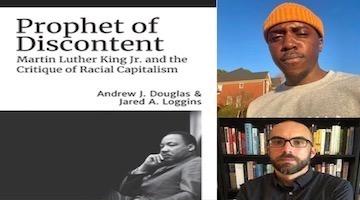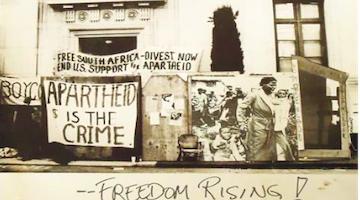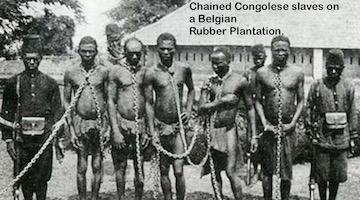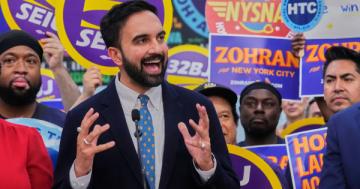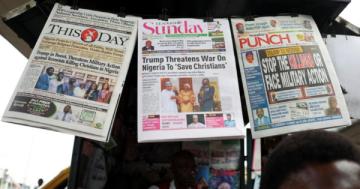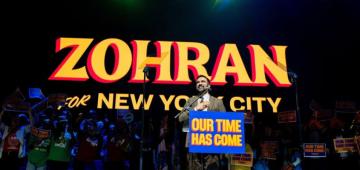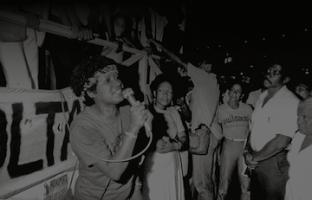Historian Elizabeth Hinton’s book reveals that, in the late sixties and early seventies, there were hundreds of local rebellions against white violence and racial inequality.
“These events did not represent a wave of criminality, but a sustained insurgency.”
Since the declaration of Martin Luther King, Jr.,’s birthday as a federal holiday, our country has celebrated the civil-rights movement, valorizing its tactics of nonviolence as part of our national narrative of progress toward a more perfect union. Yet we rarely ask about the short life span of those tactics. By 1964, nonviolence seemed to have run its course, as Harlem and Philadelphia ignited in flames to protest police brutality, poverty, and exclusion, in what were denounced as riots. Even larger and more destructive uprisings followed, in Los Angeles and Detroit, and, after the assassination of King, in 1968, across the country: a fiery tumult that came to be seen as emblematic of Black urban violence and poverty. The violent turn in Black protest was condemned in its own time and continues to be lamented as a tragic retreat from the noble objectives and demeanor of the church-based Southern movement.
On the fiftieth anniversary of the March on Washington, in August, 2013, then President Barack Obama crystallized this historical rendering when he said, “And then, if we’re honest with ourselves, we’ll admit that, during the course of fifty years, there were times when some of us, claiming to push for change, lost our way. The anguish of assassinations set off self-defeating riots. Legitimate grievances against police brutality tipped into excuse-making for criminal behavior. Racial politics could cut both ways as the transformative message of unity and brotherhood was drowned out by the language of recrimination.” That, Obama said, “is how progress stalled. That’s how hope was diverted. It’s how our country remained divided.”
“The violent turn in Black protest was condemned in its own time and continues to be lamented as a tragic retreat from the noble objectives.”
This perception of riots as the decline of the nonviolent movement has marginalized the study of them within the field of history. As a result, our conventional wisdom about “the riots” of the sixties vastly underestimates the scale of Black insurgency and its political meaning. In her new book, “America on Fire: The Untold History of Police Violence and Black Rebellion Since the 1960s,” the Yale historian Elizabeth Hinton recovers a much longer and more intense period of Black rebellion, which continued into the nineteen-seventies. In doing so, she challenges the dismissal of what she describes as the “violent turn” in Black protest, forging new ground in our understanding of the tactics employed by African-Americans in response to the extralegal violence of white police and residents and the unresolved issues of racial and economic inequality.
Using data compiled by the Senate Committee on Government Operations and the Lemberg Center for the Study of Violence, Hinton compiles a breathtaking list of more than a thousand uprisings, far beyond those with which we are most familiar. We have vastly underestimated the degree to which America was literally on fire from 1968 to 1972, years that Hinton compellingly describes as the “crucible period of rebellion.” Indeed, there were more than six hundred rebellions in 1970 alone. Hinton also makes the key finding that almost all of these rebellions came in response to escalating police interventions, intimidation, and harassment. She writes, “The history of Black rebellion across regions and decades demonstrates a fundamental reality: police violence precipitates community violence.”
“Hinton compiles a breathtaking list of more than a thousand uprisings, far beyond those with which we are most familiar.”
In the summer of 1968, in Stockton, California, two police officers tried unsuccessfully to break up a party in a public-housing development. The situation quickly escalated when more than forty more white cops arrived, Hinton writes, turning the “party into a protest.” Police ordered the crowd to disperse; instead they pelted police with rocks and bottles. The police made some arrests, but they hardly restored order. The following day, two officers were dispatched to investigate reports of a disturbance at the gym in the housing development; residents locked the cops inside the gym, and, Hinton writes, for more than two hours, a crowd of two hundred and fifty people “hurled firebombs, rocks, and bottles at the building screaming ‘Pigs!’ and other expletives.” More than a hundred police, sheriff’s deputies, and highway patrolmen arrived on the scene; the crowd released the two officers but continued to throw firebombs at the gymnasium, nearby cars, and even an elementary school. Many of them were teen-agers. Eventually, police called their parents, a strategy that worked as the kids finally went home.
In Akron, Ohio, in August, 1970, police attempted to break up a fight between Black youths; a gathering crowd attacked them with rocks for several hours. The following day, the violence escalated, as young people hurled heavier debris, such as concrete blocks and bottles, and damaged cars and injured bystanders. Finally, after two days of skirmishes with police, Hinton writes, “one thousand people, mostly of junior high school age, came out throwing rocks and other objects.” Police deployed more than thirty cannisters of tear gas to disperse the rebels, but the presence of police was, itself, the provocation. Officers moved to the perimeter so they could monitor but not further agitate the crowd. This was a short-lived strategy: they then made another show of force, touching off another round of conflict, which, according to reports, resulted in property destruction.
“For more than two hours, a crowd of two hundred and fifty people “hurled firebombs, rocks, and bottles at the building screaming ‘Pigs!’”
Similar rebellions occurred from Lorman, Mississippi, to Gum Spring, Virginia, in 1968, and Pine Bluff, Arkansas, to Erie, Pennsylvania, in 1970. Though the South is seen as the site of the nonviolent civil-rights movement and the North as where its noble objectives died, the wide scale of Black uprisings, from Southern towns to Midwestern cities, reveals widespread dissatisfaction with peaceful protest as a means to accomplish social change—which may suggest that we reconsider the assumption that the civil-rights movement was successful. For Hinton, the sheer scale of the uprisings, involving tens of thousands of ordinary Black Americans, challenges the idea that these were mindless “riots” involving wayward or misguided people. So, too, does the fact that Black violence almost always came in response to white violence aimed at controlling the ambitions and lives of Black people. Hinton writes: “These events did not represent a wave of criminality, but a sustained insurgency. The violence was in response to moments of tangible racism—‘a single incident,’ as [President Lyndon] Johnson said—almost always taking the form of a police encounter. Yet the tens of thousands of Black Americans who participated in this collective violence were rebelling not just against police brutality. They were rebelling against a broader system that had entrenched unequal conditions and anti-Black violence over generations.”
Hinton is not just recovering Black resistance; she is also exposing a long, and ignored, history of white political violence, used to maintain the subordinated status of Black communities. Hinton’s book begins by acquainting readers with the history of post-emancipation white vigilantism, which lasted well into the twentieth century. The most infamous of these assaults took place in 1921, in Tulsa, Oklahoma, where three hundred African-Americans were massacred by their white neighbors. But, even after the Second World War, as millions of Black Americans escaped the suffocating racism of the American South, they were greeted elsewhere by white mobs anxious to keep them confined to segregated enclaves. It is no exaggeration to say that tens of thousands of white people participated in riotous forms of violence to, as Hinton writes, police “the activities of Black people and to limit their access to jobs, leisure, the franchise and to the political sphere.”
“White supremacists and police converged, in the name of law and order, to dominate rebellious Black communities.”
White police were not only reluctant to arrest white perpetrators; in many instances, they participated in the violence. Hinton dedicates an entire chapter to the ways in which white supremacists and police converged, in the name of law and order, to dominate rebellious Black communities. Outside of large metropolitan areas, understaffed police forces deputized white citizens to patrol and control Black protests. According to Hinton, in August of 1968, in Salisbury, Maryland, the police department “installed an all-white, 216-member volunteer force to aid the regular 40-man force in the event of a riot.” In other instances, white cops allowed white residents to harass, beat, shoot, and even murder African-Americans with no reprisals. In the small town of Cairo, Illinois, a Black rebellion in 1967 brought together white police and white vigilantes in a concerted effort to isolate and suppress African-Americans. After the initial uprising, sparked by the suspicious death of a Black soldier in the city jail, white residents formed a vigilante group dubbed the Committee of Ten Million—a name inspired by a letter written by the former President Dwight Eisenhower, which called for a “committee of ten million citizens” to restore law and order after the uprisings in Detroit and Newark. Cairo police deputized this group to patrol Black neighborhoods, including the public-housing development Pyramid Courts, where the majority of the nearly three thousand Black people of Cairo lived. In 1969, the “white hats,” as the committee members had taken to calling themselves, fired shots into Pyramid Courts. When Black residents took up arms in self-defense, periodically curfews were imposed but applied only to Pyramid Courts residents. In response, the National Guard was periodically deployed to police Pyramid Courts. But local police would also fire into the development with machine guns from an armored vehicle (described by Black locals as the Great Intimidator). No one was killed, but Black families would sometimes sleep in bathtubs to avoid the gunfire. Black men also shot out the street lights to obscure the view of white snipers. This amounted to a war on the Black residents of Cairo, which lasted until 1972. Hinton recounts that the mayor of Cairo gave an interview to ABC News, in 1970, in which he said, of Black citizens, “If we have to kill them, we’ll have to kill them. . . . It seems to me that this is the only way we are going to solve our problem.” Hinton goes on to observe that, in all of the hundreds of rebellions of this period, “the police did not arrest a single white citizen. . . . even though white citizens had been perpetrators and instigators. White people could attack Black people and face no consequences; Black people were criminalized and punished for defending themselves and their communities.”
“Local police would also fire into the development with machine guns from an armored vehicle.”
Hinton builds upon the arguments of her previous book, “From the War on Poverty to the War on Crime,” to explain how the rebellions of the 1968-72 period came to be overlooked. Lyndon Johnson’s declaration of a “war on crime,” in 1965, opened up new and lavish spending to local law enforcement, reducing the need for the deployment of the National Guard and federal troops to put down Black rebellions. The absence of federal intervention removed these conflicts from national focus, making them local matters. Meanwhile, the buildup of local police forces, loosely packaged as “community policing,” promoted police encroachment into all aspects of Black social life, transforming typical youthful transgressions into fodder for police assaults on young Black people. Places where Black youth congregated, including public-housing developments, public schools, and historically Black colleges and universities, were now sites of police surveillance and potential arrest. These encounters between police and Black youth set the stage for what Hinton describes as “the cycle” of police abuse, in which police incursions provoked a violent response, which justified greater police presence and, in another turn, more combative responses. In this period, which saw the ascendance of the Black Panther Partyand the radicalization of Black politics far beyond the expectation of simply achieving equality with whites, young Black people in working-class communities fought back against police attempts to criminalize their daily activities or to ensnare them in the life-altering criminal-justice system.
Black resistance took different forms, from Black residents pelting police with bricks and bottles to Black snipers shooting at police, with the purpose of driving them out of their communities. Black snipers, in particular, fulfilled political fantasies that demonized all forms of Black resistance as pathological and deserving of violent pacification. From 1967 to 1974, the number of police killed in the line of duty jumped from seventy-six to a hundred and thirty-two, the highest annual figure ever. But those totals were dwarfed by the number of young Black men killed by the police in the same period. Hinton reports that, between 1968 and 1974, “Black people were the victims of one in four police killings,” resulting in nearly a hundred Black men under twenty-five dying at the hands of police in each of those years. By comparison, today only one in ten people killed by police is Black, according to the Centers for Disease Control. (Hinton cites this figure but notes that it may represent underreporting.)
“Black snipers fulfilled political fantasies that demonized all forms of Black resistance as pathological and deserving of violent pacification.”
This cycle of abuse could not continue. The crucible period of rebellion was over by the end of the seventies. It was not reform that brought its end; it was repression. Prison became a way of dealing with pugnacious Black youth. By the mid-seventies, according to Hinton, seventy-five percent of African-Americans imprisoned were under the age of thirty. Rebellion as a collective rejection of the quotidian acts of police violence became infrequent, she writes, as “Black Americans had more or less resigned themselves to the policing of everyday life.” For the past forty years, uprisings in response to police abuse have “tended to break out only after exceptional incidents of police brutality or miscarried justice.”
In some of the most powerful parts of “America on Fire,” Hinton systematically unravels the failures of police reform. More than fifty years ago, the Kerner Commission reached the damning conclusion that, unless there were a massive redistribution of resources into Black communities, patterns of segregation across the United States would deepen and, along with them, resentment and retaliation by African-Americans. As the report observed:
No American—white or black—can escape the consequences of the continuing social and economic decay of our major cities. Only a commitment to national action on an unprecedented scale can shape a future compatible with the historic ideals of American society. The major need is to generate new will—the will to tax ourselves to the extent necessary, to meet the vital needs of the nation.
But, without clear mechanisms for enforcement of the commission’s recommendations, they went unheeded. Kerner established a model for commissions on race, policing, and inequality that has persisted to the present, creating a rich archive of public hearings documenting the racism and abuse directed at Black citizens that has led to very little being done about it.
“Hinton systematically unravels the failures of police reform.”
This bleak reality is evidence of the shortsightedness of the liberal premise that exposing a problem is the first step in its resolution. In fact, as the Kerner Commission explained, fixing those problems would require unprecedented action. It would mean using the powers of the judiciary and the federal bureaucracy to dismantle systems of residential segregation, school segregation, and the racial segmentation of American workplaces. It would also mean leveraging financial resources to end the endemic poverty that made Black Americans disproportionately vulnerable and visible to police in the first place. Instead, just months after the publication of the Kerner Report, Richard Nixon ran a successful Presidential campaign impugning Black rebellion as mere “crime” while arguing that he could restore law and order in the nation’s cities. When running for reëlection, in 1972, Nixon coupled his theme of law and order and a new declaration of a “war on drugs” with an anti-welfare message that would become a theme of Republican politics for a generation, cohering a new, white “silent majority” around the politics of racial resentment and subordinating the demands of the Black minority. Hinton paints a bleak picture, in which the dual agenda of the Reagan Administration, of strengthening law enforcement while weakening social programs, helped to maintain the conditions that legitimized the expanding powers of police and growing prison populations. Though rising murder rates seemed to blunt the logic that more crime-control measures would make people safer, any skepticism was easily depicted as insufficient concern about safety and crime. Politically, elected officials goaded one another to demand tougher laws, tougher punishment, tougher enforcement. Between 1970 and 1980, the number of people incarcerated in federal and state prisons jumped by fifty per cent.
More than fifty years after the Kerner Commission, we have seen in the past eight years the return of Black rebellions in response to growing inequality that has been managed by the forces of racist and abusive policing. This is not history repeating itself; it is evidence that the problems that gave rise to earlier Black rebellions have not been resolved. Hinton observes that the “contemporary movement for racial justice has built upon earlier traditions, creating a type of militant, nonviolent protest that blended the direct action tactics of the civil rights movement with the critiques of systemic racism that are often identified with Black power.” Hinton argues that the persistence of inequality, coupled with new cycles of violence between the policed and law enforcement, is evidence that we must “move beyond reform.” But the enormousness of that task seems to stop Hinton in her tracks. She is not naïve about the difficulty of effecting the changes that are necessary to rein in abusive police while also solving deep and long-standing inequities that always legitimize policing. With this in mind, she avoids the temptation to neatly wrap up this history with simplistic suggestions for more public policies that stand no chance of approval or will inevitably fail to be enforced. She does, however, suggest that regressive-taxation formulas that starve public programs of funding be reformed. She also calls for establishing a justice system “based on the principle of repair instead of retribution.” But these recommendations pale in comparison with the power of collective protest that she expertly documents throughout the book.
“We have seen in the past eight years the return of Black rebellions in response to growing inequality.”
There are no easy answers to the question of how to end the cycle of racist and abusive policing, but the force of resistance and rebellion has been the most effective way of both exposing the problem and pressuring authorities to act. The biggest difference between now and the earlier crucible period of rebellion is that today’s uprisings are increasingly multiracial. Since the uprising in Los Angeles in 1992 and certainly the rebellions of last summer, Latinx and ordinary white people have been inspired by rebellion as a legitimate form of protest. The rebellions of last summer involved thousands of white people who were also angered by the abuses of police and by the deepening unfairness of our society. Protesters’ demands to “defund the police” brought together new coalitions to challenge the entwined political realities of funding law enforcement and ignoring social-welfare services while injecting new arguments into the public discussion of this very old problem of racist police abuse. This won’t end police brutality, but it can expand the number of people who also see themselves as victimized by deformed public policies. The larger the movement, the harder it is to maintain the status quo.
Keeanga-Yamahtta Taylor is an Assistant Professor in the Department of African- American Studies at Princeton University.
This article previously appeared in The New Yorker.
COMMENTS?
Please join the conversation on Black Agenda Report's Facebook page at http://facebook.com/blackagendareport
Or, you can comment by emailing us at comments@blackagendareport.com




